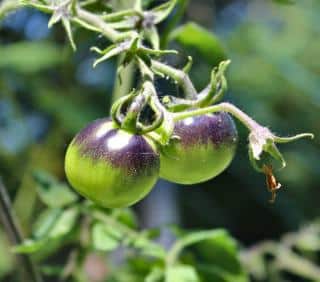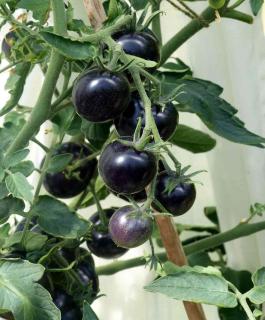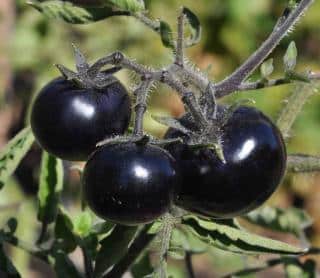

‘Indigo Rose’ tomato key facts:
Botanical name – Solanum lycopersicum
Family – Solenaceae
Type – fruit vegetable
Height – 6 feet (2 m)
Planting distance – 20 to 24 inches (50 to 60 cm)
Exposure – full sun
Soil – rich and well-draining
Planting – May
Harvest – June to end of September
The ‘Indigo Rose’ tomato is a cocktail-type variety: it produce bunches of small round fruits that are a deep violet-blue color, nearly black, that lightens to a brown-red hue when ripe. The surprising dark color comes from a particular pigment in its fruits called anthocyane. It’s the same pigment that also gives their color to blueberries and grapes.
The flesh ranges in color from pink to dark purple. It tastes soft and has a strong fragrance. This tomato is known to contain lots of antioxydants. A hardy tomato to the cold that is a vigorous grower, the ‘Indigo Rose’ variety is an easy variety to grow, and you can harvest it over a long span of time.
Sowing for ‘Indigo Rose’ starts in February in warm temperatures, such as a heated germination bed. Another good set-up is a series of nursery pots, which you can start anytime from March to April. In both cases, you should aim for a constant temperature of about 68°F (20°C).
When your new ‘Indigo Rose’ tomato seedlings reach about 6 inches (15 cm), the time has come to transplant them. If you’re aiming to transfer them directly to the growing bed, make sure all risk of freezing is over.
 Choose a place for it that is in full sun, if possible with a wall that faces towards the midday sun to lean on.
Choose a place for it that is in full sun, if possible with a wall that faces towards the midday sun to lean on.Amend the soil at the bottom of the hole with a little bit of compost and bury the seedling all the way up to the first pair of leaves. Backfill, then stake the plants and water abundantly (but without getting the leaves wet).
The ‘Indigo Rose’ tomato variety is a particularly vigorous one, and it resists the cold better than most other varieties. This makes it quite an easy variety to grow, even in simple, ordinary soil – though of course rich soil that drains well will truly lead it to thrive.
 Staking is nearly mandatory, since this variety easily grows to 6 feet (2 meters).
Staking is nearly mandatory, since this variety easily grows to 6 feet (2 meters).
Though it resists cooler temperatures well, it’ll still wither away during the colder autumn nights, so in our climates it’s typically grown as an annual. The only care that’s needed on a regular basis is to make sure you’ve got a layer of organic mulch along the base of your ‘Indigo Rose’ tomatoes, to make sure the soil stays moist and to greatly reduce the need to weed.
This tomato doesn’t need much water to survive because its root system reaches deep into the soil. Only water in case of prolonged heat wave.
The ‘Indigo Rose’ variety is not protected against mildew, a fungal disease that often appears whenever moisture abounds. Tip necrosis might also occur in case of lack of calcium in the soil.
 The harvest season for ‘Indigo Rose’ tomatoes is particularly long, since it produces fruits deep into the month of September. Harvest ripe bunches when they’ve reached peak maturity.
The harvest season for ‘Indigo Rose’ tomatoes is particularly long, since it produces fruits deep into the month of September. Harvest ripe bunches when they’ve reached peak maturity.
The fact that they’re so full of water explains why tomato doesn’t usually keep for a very long time after they’ve been harvested. You can spread them out in the open air, or, if you haven’t the space, store them in the vegetable compartment of your refrigerator, but they’ll only last a few days. Another option is to can or preserve your ‘Indigo Rose’ harvest, storing them in jars for months.
As with most other cocktail type tomatoes, this small tomato often serves as an excellent finger food for early guests or before meals, raw. Delicious when savoring a few beers or appetizers with friends, either just as they are or sliced open and lathered with cream cheese.
Add ‘Indigo Rose’ tomatoes to salad, where its unexpected dark color will intrigue the eyes before satisfying your taste buds in an original and ornamental manner.
As a cooked or baked tomato, however, you’ll be sorely disappointed, since this tomato doesn’t really hold well to heat.